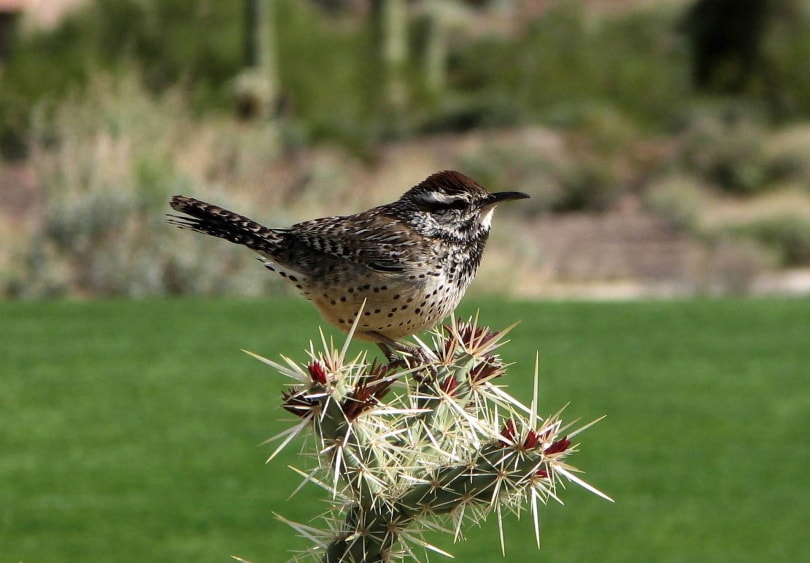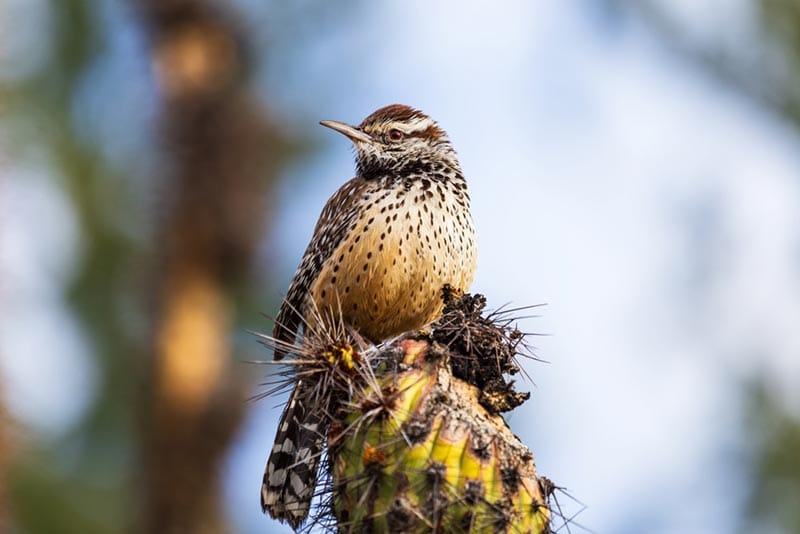Cactus Wren: Field Guide, Pictures, Habitat & Info
Last Updated on

The Cactus Wren is a striking bird with a unique sound. Despite their bold personalities, these birds have a romantic side and sometimes mate for life. Even if they don’t mate for life, they are almost always seen in pairs.
If you are interested in spotting the Cactus Wren, you have to be in the right location. They are mainly found in the southwest desert, around Texas, New Mexico, Arizona, Nevada, and California.

Quick Facts about Cactus Wrens

| Habitat: | Southwestern US and Mexico; arid locations |
| Diet: | Mainly insects with some berries and fruit |
| Behavior: | Can mate for life; normally seen in pairs |
| Nesting: | Nest 10–30 feet above ground in trees and shrubs |
| Conservation: | Least concern |
| Scientific name: | Campylorhynchus brunneicapillus |
| Lifespan: | 7–10 years |
Cactus Wren General Description
The Cactus Wren is a bold-looking bird. It is between the size of a sparrow and a robin. Its body is speckled with brown and white. It has notable white eyebrows that start at the bill and go all the way across their eyes.
The sides of these birds are beautiful. They are primarily cinnamon brown and have dark speckles. The chest, in contrast, is primarily white, but it has dark speckles, too. The back is different from both in that it is mainly brown with white streaks.
The tail is a combination of white and black bars. This tail is noticeable from below when it is fanned out.
Both males and females have this appearance and look alike. The juveniles are a little paler, though. Juveniles also have brown eyes, whereas adults have red eyes.

Cactus Wren Range, Habitat, Behavior, Diet & Nesting
The Cactus Wren is not found all throughout the United States. Instead, it is only found in desert, southwestern locations.
Range
The range of the Cactus Wren is rather specific. The bird is only found in Texas, New Mexico, Arizona, California, and parts of Nevada. Outside of the United States, it is primarily found in Mexico, which is where it is most common. Some species extend further down than Mexico, but this is not very common.
Habitat
Within this range, Cactus Wrens prefer to live in arid locations, including arid deserts and foothills. They can also be found around coastal sage shrubs and in urban locations right around the desert. They are super popular in areas that have a lot of prickly pears, thorny shrubs, and cholla.
Behavior
The Cactus Wren is a lot braver than most other Wren species. Whereas most wrens like to hide away, the Cactus Wren perches atop shrubs, cacti, and other items. They forage out in the open and are very open about their presence.
Cactus Wrens are also different from other species in that they don’t hide their tails. Instead, their tail feathers are normally fanned out, which allows them to flash their white tips.

Diet
This species primarily eats insects, but they also eat fruits and seeds. They prefer ants, beetles, grasshoppers, wasps, and true bugs, but they will also eat spiders and small lizards. Only about 20% of their diet comes from plant matter.
Nesting
Whenever males and females first meet, they have a flashy display where the wings and tails are spread. Cactus Wrens are normally seen in pairs, and they sometimes mate for life. At the minimum, pairs stay together for an entire year.
After mating, males normally make dummy nests, and the females incubate on the real nest. This is done because adults often puncture other eggs. You’re most likely to find nests in cacti, thorny low trees, or Yucca. The nests are anywhere from 10–30 feet off the ground.
The nest itself, which is made by both parents, is made up of a lot of weeds, grass, animal hair, and twigs. The inside is lined with feathers. The nest almost looks like a football that is laying on its side, but it has an entrance on one end. The bird nests within.

How to Find Cactus Wrens: Birdwatching Tips
If you are in the right area, spotting a Cactus Wren is relatively easy. Because they are bold and flamboyant, they don’t fly away and instead make themselves known.

What to Listen For
The Cactus Wren has a very distinct song that almost sounds like a car that won’t start. The sounds are often harsh and raspy. Most of the sounds you hear are from the male. Females sometimes sing, but their pitch is so high and soft that it is rarely heard.
What to Look For
The easiest way to spot a Cactus Wren is to look for one. Look for flamboyant, speckled birds that are sitting atop thorny shrubs and cacti. You will have to be in an arid, southwestern location in order to see them.
When to Look
Cactus Wrens are common year-round in the southwestern United States. Because the weather is relatively stable here, they don’t come and go for breeding purposes. So, you can look at any time to find Cactus Wren in the area.
Attracting Cactus Wrens to Your Backyard: Tips & Tricks
If you want to attract a Cactus Wren to your yard, you first have to be in the right location. Individuals who live outside of the southwestern United States are simply out of luck. Those who live within the range can do things to attract the Cactus Wren to their yard.
First, plant shrubs that this species loves. Native shrubs that produce berries and provide winter food sources are best. Keep in mind that they also love shrubs with spikes and a lot of texture.
Secondly, put up a bird feeder with their favorite food. This species likes suet, shelled peanuts, and peanut butter. Because Cactus Wrens are not shy, they will come to the food once they find it.
Cactus Wren Conservation: Is this Bird Threatened?
The Cactus Wren is widespread and abundant in the southwestern area. However, there are some studies that suggest the population is declining in certain areas, notably Texas and California. Still, this species is not threatened.

Final Thoughts
If you live in the Southwestern United States, you are in luck. You will be able to spot Cactus Wrens, which are abundant year around. Look for speckled birds that almost sound like a faulty car, and you know you’ve found the Cactus Wren!
Featured Image Credit: David Mark, Pixabay
About the Author Robert Sparks
Robert’s obsession with all things optical started early in life, when his optician father would bring home prototypes for Robert to play with. Nowadays, Robert is dedicated to helping others find the right optics for their needs. His hobbies include astronomy, astrophysics, and model building. Originally from Newark, NJ, he resides in Santa Fe, New Mexico, where the nighttime skies are filled with glittering stars.
Related Articles:
10 Types of Hummingbirds in Arkansas (With Pictures)
8 Types of Hummingbirds in Nebraska (With Pictures)
5 Types of Hummingbirds in Idaho (With Pictures)
3 Types of Hummingbirds in Mississippi (With Pictures)
8 Types of Hummingbirds in Kansas (With Pictures)
5 Types of Hummingbirds in West Virginia (With Pictures)
5 Types of Hummingbirds in Ohio (With Pictures)
Where Do Nuthatches Nest? Nuthatch Nesting Habits Explained
